Elephants injured and/or orphaned by the poaching
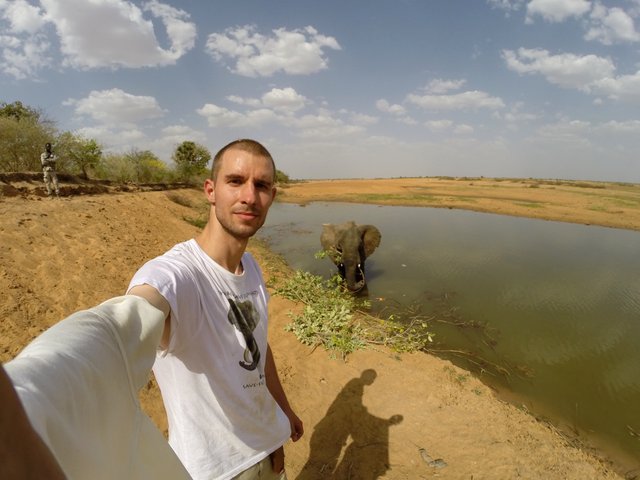
Arthur F. Sniegon with an injured female elephant behind in Central Chad, 2017
Not all elephants being targeted by poachers die at the place in the shooting event. Across Africa there are lots of elephants injured by the firearms or traps or elephant calves who lose their mother and family and become orphans.
Poachers are generally attempting to approach their prey to a close distance and open free view to aim precisely and spare ammunition, but this is not always possible due to thick vegetation or the fact that bush elephants create big herds and not all individuals can be approached at the same time. Numerous injuries are results of such encounters and the victims sometimes die later (being or not being tracked down by the poachers) or heal and recover. The aggravating fact making the recovery of an elephant more difficult is that these animals are migratory and by the pursuit of forage and water need to cover enormous distances. Therefore they can not afford losing time (= energy – calories intake) by waiting and are forced to walk, - no matter the pain and disability. Sometimes these animals can not keep the pace with their fellow elephants and become solitary – which is moreover making them more vulnerable to predators (lions, hyenas – in case of smaller elephants) and prone to not being able to find sufficient resources, since the knowledge of the latter is something to be taught, inherited and experienced throughout the lifetime from the older elephants, i.e. the leading matriarch. Therefore the lone abandoned elephants have limited chances or survival.
The injuries can last for many years or for the whole rest of life and can affect its quality. Limping elephants can be found with swollen extremities and inflamed abscesses hanging up with their herds but being considerably slower and sometimes malnourished.
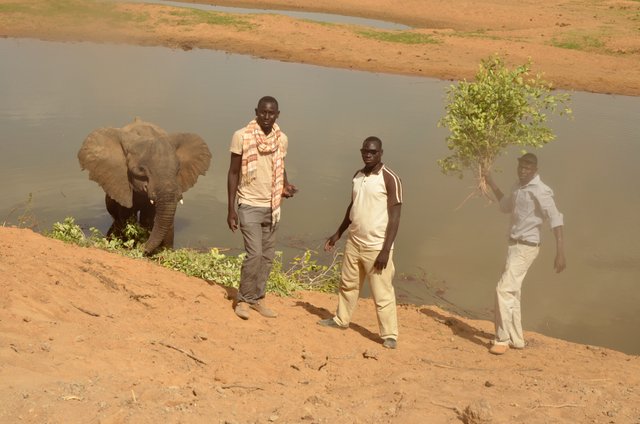
Members of SOS Elephants in Central Chad collect fresh vegetation to offer it to the injured elephant.
This was the case of a bush elephant female injured in March 2017 in Central Chad to her hind-thigh. Around 17 or more of her family members have been shot dead and she survived being in pain of an inflamed injury and unable to walk fast for another few weeks, and later died as well near the banks of Chari river. Meanwhile the conservationists from SOS Elephants organized a daily delivery of fresh tree branches and hay to her (which she appreciated and consumed with big appetite), but her end was inevitable.
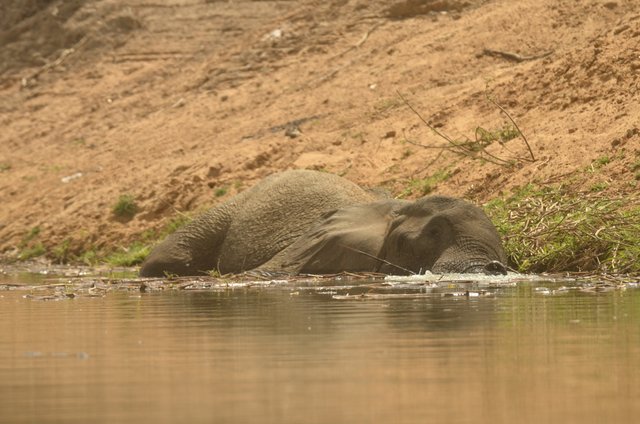
The female elephant resting during the heat of the day in a muddy pool of water in Chari river.
When a baby elephant or an youngster becomes orphan and loses also its family/clan, the chances for survival are dramatically dropping with every hour and every day spent alone without proper care of professionals.
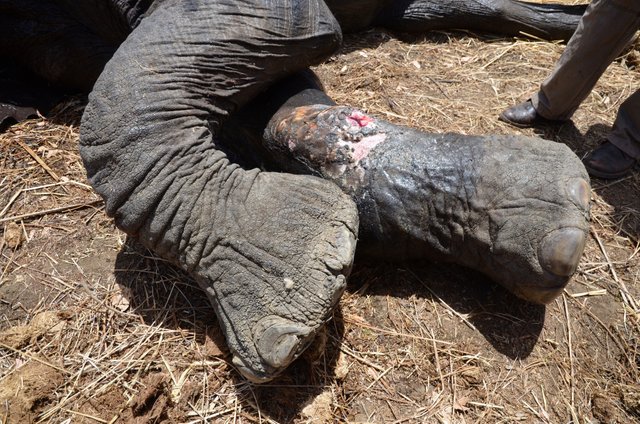
In East Africa the orphans have a much greater chance thanks to facilities dedicated to their rescue. A splendid example being The David Sheldrick's Elephant Orphanage adjacent to the Nairobi National Park just outside of Kenya's capital. Dozens of orphaned and sometimes also injured baby bush elephants are fed and taken care for many years before they are ready to be released (not alone, but along with their equally handicapped friends and to a group of adult elephants) to the vast plains of Tsavo ecosystem.
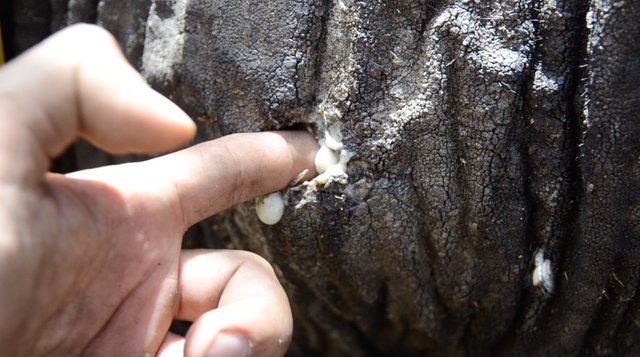
A bush elephant's right foreleg inflamed after being shot by poachers. This elephants has been put asleep by Zakouma National Park to carry a GPS devise collar.
In Central Africa however there is not such a regular facility and program to rescue the elephants also because of the fact that most orphans go unnoticed and conservationists are not even aware about their existence. And if yes, it is sometimes too late. The orphans on their own suffer enormous stress, hunger, thirst and possible attacks of animals or humans and if their at last appear in the care of conservationists, they are considerably weakened.
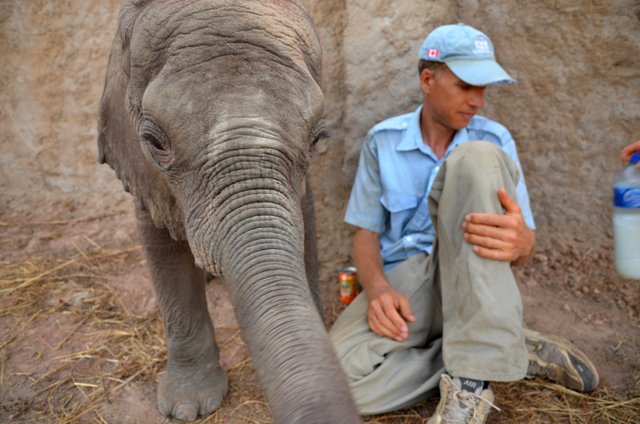
The US pilot Gary Roberts rests beside Max, the baby elephant orphan in Chad after having transferred him to a safe refuge in his little Cessna aircraft.
This was the case of Max the baby elephant who became victim of brutal slaughter of 90 of his clan members in March 2013 in western Chad. Max probably just under one year of age roamed for a couple of days the extremely dry (dry season) bush and then got captured by villagers who attached him with a rope around his neck to a mango tree and fed him. The rope caused deep injury and the diet was inappropriate for the elephant – cow's milk and sweet liquid porridge. This all caused another stress and diarrhea. At last he was found by flying medics Gary and Wendy Rogers based in Chad who took care of him with Arthur F. Sniegon for a couple of days. The mental condition of Max obviously improved in the calm and quite natural place with steady contact with two humans but his digestion problems did not cease, until the poor boy followed the destiny of his family members and died at the end as well.
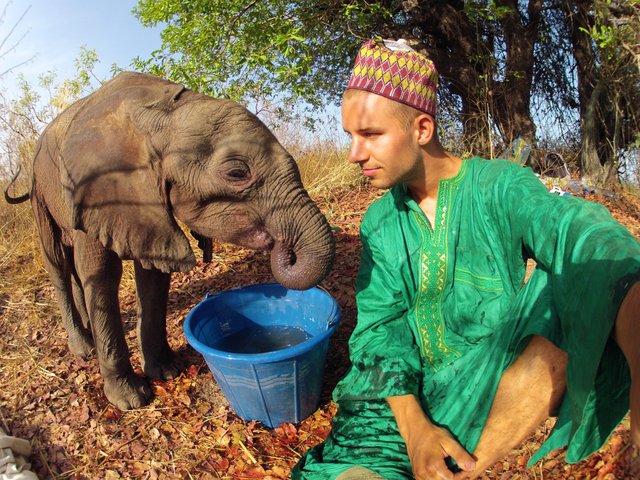
Arthur F. Sniegon taking care of Max, southern Chad 2013.
Given the unpredictable and rare occasions of young elephant becoming orphans in Central Africa, the efforts for their rescue are most often ad hoc, late and insufficient. Most of the bush elephants and 100% of forest elephant orphans in Central Africa die unnoticed and alone in the nature.
Arthur F. Sniegon, June 2018
Founder and Coordinator of @save-elephants
www.save-elephants.org
E-mail: [email protected]
FB: save.elephants.org
You just planted 0.18 tree(s)!
Thanks to @martin.mikes
We have planted already 4000.01 trees
out of 1,000,000
Let's save and restore Abongphen Highland Forest
in Cameroonian village Kedjom-Keku!
Plant trees with @treeplanter and get paid for it!
My Steem Power = 25693.91
Thanks a lot!
@martin.mikes coordinator of @kedjom-keku
Hello. The web is about to be translated soon. But meanwhile you can watch a brand new YT chanel with translater chapters of my elephant movie:
Great work and a very sad situation. Is there a translation for the web page ?
Peace
Auw this is so sad! Shocking how cruel the human race can be...
Indeed!
Člověk vždycky vidí jen ty otřesné záběry zabitých slonů, ale to, kolik zvířat útok pytláků přežije a stráví zbytek života v bolestech, si už asi moc lidí nepředstaví. Díky za osvětu a za to co, pro naši planetu děláte. Jste skvělí!
Děkuji! Věříme, že ta snaha se nemine účinkem a že více a více lidí se zapojí. Sloni, prales, oceány, sysli či ještěrky... je to všechno naše rodina...